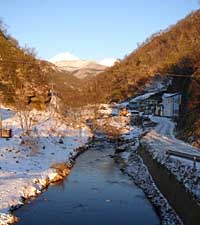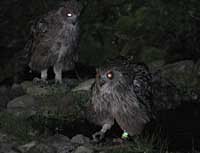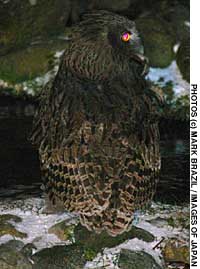Half-truths to the aid of conservation
By Mark Brazil | Jan 18, 2006
THE 'HONEY-POT' APPROACHLet’s just imagine for a moment that you are a conservationist. You discover, or become aware of, the breeding location of a rare mammal or bird, or of a site where there is an endangered plant growing. What do you do?
There are two opposing schools of thought on this. You could keep the matter secret, and hope the secret is safe with you and those you choose to share it with (assuming that they don’t pass on that information). Alternatively, you could share the information widely, hoping that safety and support comes with numbers.
Taking the first approach, the secret may indeed be safe with you (as Gandalf urged Frodo: “Keep it secret; keep it safe”), and the mammal, bird, plant or other organism may remain secure in that secrecy.
But how do you prevent someone else from stumbling across the same creature or upon the same place? And if that should happen, as likely as not you will not be able to control the decision they make — and they may be a plant-hunter, a birds’ egg-collector or an unscrupulous photographer.
Taking the second approach — spreading the information among like-minded people — perhaps will persuade them to join in and support protection of the species or the location, promote conservation education concerning the site, and, by introducing more people to it, provide further, and future, protection.
However, there is something of a middle path, the “honey-pot approach,” which I was exposed to as a keen young naturalist.
When I was growing up in Britain, birds of prey were only slowly beginning to recover from the combined ravages of pesticide overuse and over-intensive game-keeping. I remember hearing news that a single pair of fishing hawks, ospreys, had returned to Britain — Scotland to be precise — after an absence of decades, and that they were being afforded round-the-clock protection by Britain’s Royal Society for the Protection of Birds.
When a family summer holiday was announced to the Aviemore area in the Scottish Highlands, I badgered my parents to take me to the RSPB’s viewing hide. Even today, I can’t fully express my excitement at seeing this thrilling bird, and the only pair breeding in the country.
It was only several years later that I realized just how successful this middle-way strategy had been as a successful case of the honey-pot approach.
Lifelong supporters
Many young people, like myself at the time, were deeply moved by the efforts being made to protect rare wildlife, and as a result we became lifelong supporters of organizations making such efforts.
What I hadn’t known at the time, was that the osprey was in fact a reasonably common bird in other countries, and that there were other pairs breeding in Scotland. For years, television, radio and newspapers talked about the ospreys returning each summer as if they were just one pair. By focusing the public’s attention on that one honey-pot location, and by using it for effective environmental education, considerable support was won for the cause — so enabling the organizations involved to protect other pairs. The end result has been that many pairs now breed each year in Britain, and not only in Scotland, and a real population recovery has taken place.
For decades, conservationists in Japan have debated over how to deal with information concerning rare species, though there seems to be a tendency toward secrecy, almost for secrecy’s sake.
For example, I was actively discouraged by a colleague from publishing my research on the status of bats in the lowland forest near my university in Hokkaido because, as he said, it would put them at risk, even though they were not rare species. Given that other researchers have been publishing papers on bat distribution elsewhere in Hokkaido without obvious risk, I put it down to professional jealousy and published anyway — but his attitude is perhaps not uncommon.
One of Hokkaido’s rarities, the three-toed Woodpecker, seems to be so rare that it should only be talked about in hushed tones, and even fellow researchers are unwilling to talk about whether it is extant or extinct — and, if the former, where it might be.
Another enigmatic Hokkaido species is the world’s largest owl, Blakiston’s fish owl. This magnificent bird was for many years the victim of forest clearance, and the tidying away of large dead trees from riverine habitats. These are huge birds, and they need huge cavities to nest in, and there simply weren’t enough places, even when the number of individuals requiring them had plummeted.
I became involved in a conservation project for them back in the early 1980s, and spent many winter weekends dragging, heaving and hauling massive nest boxes into place to provide sites in territories that lacked them. It was a successful mission, but one that bore slow-growing fruit.
These long-lived birds produce at best one or two young a year, so their potential for population recovery is very limited. Healthy habitat for them is limited, leaving the young facing a difficult time once they are pushed out of their natal territories, and these slow-flying creatures fall easy victims to traffic accidents when their riverine habitats are close to main roads. Sadly, three died in this way last year in the Nemuro area of Hokkaido alone.
Like others involved in these owls’ conservation, even when publishing about them, I felt it necessary to be vague about their locations in order to protect them from over-zealous photographers. I still feel that approach was justified, although it became possible to take small groups of people to see them at certain research sites.
Now, however, we have a real honey-pot opportunity with this species: An opportunity to show people an astounding bird that can survive in Hokkaido’s harshest winter climate while hunting primarily for fish, rodents and frogs. It is an opportunity perhaps to win support for further conservation of their habitat.
Supreme chance
This has come about because of the unusual efforts made at a minshuku (guest house) called Minshuku Washi no Yado on the northerly Shiretoko Peninsula of Hokkaido. This area, now a World Heritage Site, is crying out for real wildlife watching opportunities, and here is a supreme chance — in a narrow river valley just beyond the town of Rausu, a pair of these fabulous birds has made their home. Each year they breed, and for several years now they have been accustomed to flying downstream from their territory to feed under lights. Tempting food is put out for them in a pool in the stream, which encourages them to return regularly to the same area to feed.
Though not guaranteed every night, the chance of seeing them there is high, and from the warmth of the minshuku visitors can watch as the owls forage just meters away across the stream — and do so without disturbing them.
There, you can not only watch, but even photograph the owls. I would encourage anyone interested to visit if you can, but while while watching them, please reflect on your privileged opportunity to see such fantastic creatures in the wild. Not only that, but consider the nature of rarity, and ponder the need for conservation of these birds and others — and perhaps return home determined to support their conservation by supporting local and national conservation groups.
If you would like directions to the minshuku, including a map, please e-mail me at the address below.



